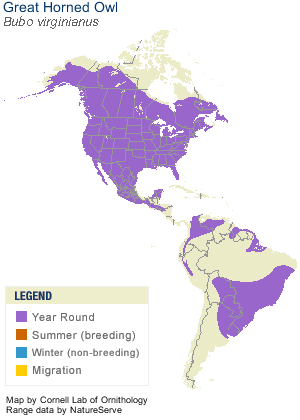Habitat and Geography
The great horned owl is the
most common owl in North America. They can be found in almost
any habitat between the arctic and the topics (All About Birds
2011). Great horned owls are found from the boreal forests of
Alaska and Canada to northern parts of South America
(Klappenbach 2014). Some common habitats they reside in include
deserts, forests, wetlands, and grasslands. Great horned owls
usually prefer to live in secondary-growth woodlands. These are
forests that have undergone some ecological disturbance but
recovered. They are generally more open than normal forests,
which the owls prefer. Great horned owls also prefer living in
swampy environment; however, they also occupy
deciduous forests. They usually live where open space can be
found close by,
such as fields. Great horned owls are also
known for residing in suburban areas, or even cities! (All About
Birds 2011). A study done in the eighties found that great
horned owls were able to maintain a stable population within
urban and suburban areas of Syracuse, New York. As long as their
nests remained undisturbed and there was available space for
foraging, the great horned owl population was able to remain a
top predator in the city (Minor et al. 1993).

Great horned owls live in more varied habitats than any other owl in North America. The owls that live in forests prefer them to be more open, or with open areas nearby. They are more often found in wooded areas during mating season because there is plenty of brush to provide cover (Bird Web 2005). To learn more about mating habits, click here.
Having such a wide variety of habitats, the great horned owl is able to adapt to many different nesting sites and a variety of prey, which is very advantageous and gives the owl great flexibility. Although very adaptable, the owls tend to avoid far northern tundra habitats, as well as densely humid deserts and jungles (About.com Birding/Wild Birds 2014). Owls that live in the far north migrate during the winter, but generally the owls live permanently in their habitats that have more temperate climates (National Geographic 2013).
In every habitat that great horned owls are found, they do not build their own nests. They actually adopt nests that were previously built by other organisms, such as other birds or squirrels (All About Birds 2011). It has even been documented in behavioral studies that the owls can take over nest presently inhabited by other birds. An observational study was done on a great horned owl that took over a pair of red tailed hawks’ nest. The owl was met with several seperate attacks by the hawks. The great horned owl, which by species is known to be aggressive when it comes to nesting, ultimately won the battle for possession of the nest (Cianfaglione 2007). After an owl finds a nest, they often line their new home with their feathers, leaves or bark. They most often nest in trees, but they can also be found nesting on cliff ledges or even the ground (All About Birds 2011). To learn more about nesting regarding reproduction, click here.